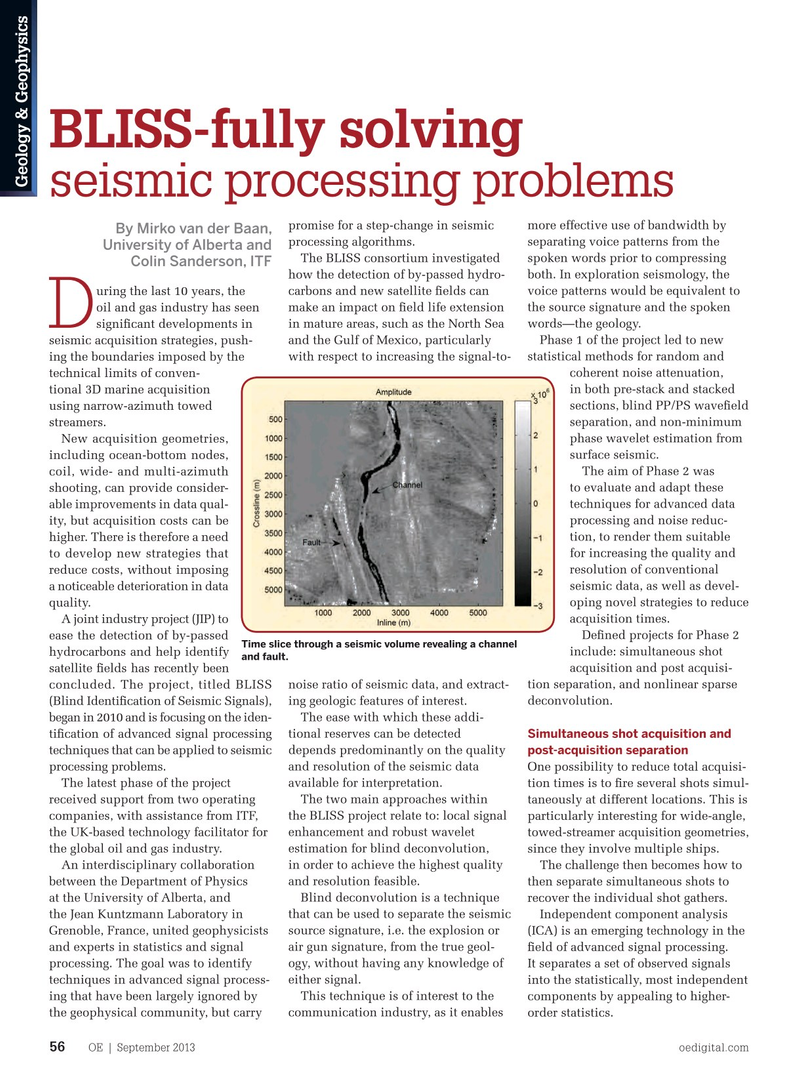
Page 54: of Offshore Engineer Magazine (Sep/Oct 2013)
Read this page in Pdf, Flash or Html5 edition of Sep/Oct 2013 Offshore Engineer Magazine
BLISS-fully solving
Geology & Geophysics seismic processing problems promise for a step-change in seismic more effective use of bandwidth by
By Mirko van der Baan, processing algorithms. separating voice patterns from the
University of Alberta and
The BLISS consortium investigated spoken words prior to compressing
Colin Sanderson, ITF how the detection of by-passed hydro- both. In exploration seismology, the uring the last 10 years, the carbons and new satellite felds can voice patterns would be equivalent to oil and gas industry has seen make an impact on feld life extension the source signature and the spoken signifcant developments in in mature areas, such as the North Sea words—the geology.
D seismic acquisition strategies, push- and the Gulf of Mexico, particularly Phase 1 of the project led to new ing the boundaries imposed by the with respect to increasing the signal-to- statistical methods for random and technical limits of conven- coherent noise attenuation, tional 3D marine acquisition in both pre-stack and stacked using narrow-azimuth towed sections, blind PP/PS wavefeld streamers. separation, and non-minimum
New acquisition geometries, phase wavelet estimation from including ocean-bottom nodes, surface seismic.
coil, wide- and multi-azimuth The aim of Phase 2 was shooting, can provide consider- to evaluate and adapt these able improvements in data qual- techniques for advanced data ity, but acquisition costs can be processing and noise reduc- higher. There is therefore a need tion, to render them suitable to develop new strategies that for increasing the quality and reduce costs, without imposing resolution of conventional a noticeable deterioration in data seismic data, as well as devel- quality. oping novel strategies to reduce
A joint industry project (JIP) to acquisition times. ease the detection of by-passed Defned projects for Phase 2
Time slice through a seismic volume revealing a channel hydrocarbons and help identify include: simultaneous shot and fault. satellite felds has recently been acquisition and post acquisi- concluded. The project, titled BLISS noise ratio of seismic data, and extract- tion separation, and nonlinear sparse (Blind Identifcation of Seismic Signals), ing geologic features of interest. deconvolution. began in 2010 and is focusing on the iden- The ease with which these addi- tifcation of advanced signal processing tional reserves can be detected
Simultaneous shot acquisition and techniques that can be applied to seismic depends predominantly on the quality post-acquisition separation processing problems. and resolution of the seismic data One possibility to reduce total acquisi-
The latest phase of the project available for interpretation. tion times is to fre several shots simul- received support from two operating The two main approaches within taneously at different locations. This is companies, with assistance from ITF, the BLISS project relate to: local signal particularly interesting for wide-angle, the UK-based technology facilitator for enhancement and robust wavelet towed-streamer acquisition geometries, the global oil and gas industry. estimation for blind deconvolution, since they involve multiple ships.
An interdisciplinary collaboration in order to achieve the highest quality The challenge then becomes how to between the Department of Physics and resolution feasible. then separate simultaneous shots to at the University of Alberta, and Blind deconvolution is a technique recover the individual shot gathers. the Jean Kuntzmann Laboratory in that can be used to separate the seismic Independent component analysis
Grenoble, France, united geophysicists source signature, i.e. the explosion or (ICA) is an emerging technology in the and experts in statistics and signal air gun signature, from the true geol- feld of advanced signal processing. processing. The goal was to identify ogy, without having any knowledge of It separates a set of observed signals techniques in advanced signal process- either signal. into the statistically, most independent ing that have been largely ignored by This technique is of interest to the components by appealing to higher- the geophysical community, but carry communication industry, as it enables order statistics.
OE | September 2013 oedigital.com 56 056_OE0913_G&G-2-Bliss.indd 56 8/18/13 8:26 PM

 53
53

 55
55